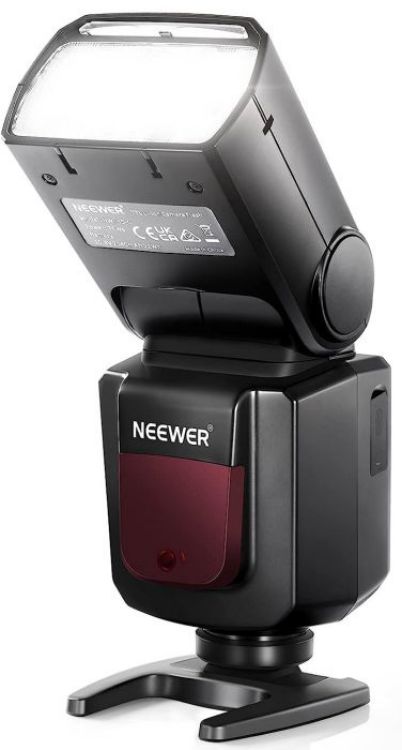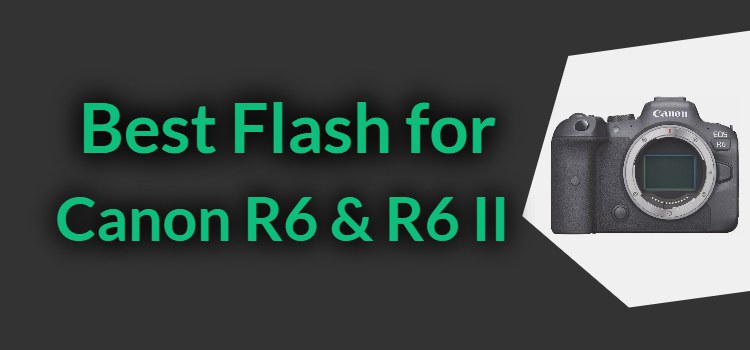
In the world of photography, Capturing the perfect shot often requires a delicate balance of light and shadow, which is the one thing you cannot achieve with any advanced camera until you add a complimentary external flash on it.
Enter the world of flashes- A magnificent burst of illuminating magic that holds the power to transform the ordinary scene into a mesmerizing masterpiece. So, if you are a proud owner of Canon R6 and R6 II, you might get all your attention here.
| Best Flash for Canon EOS Canon R6 & R6 II |
|---|
| NEEWER NW665-C (Best TTL Flash)
|
| Godox V860III-C (Most High-end and Advanced TTL Flash)
|
| Altura AP-305C (Budget TTL Flash)
|
| Godox V850III (Best Manual Flash)
|
| Altura AP-UNV2 (Budget Manual Flash)
|
In this article, I invite you to embark on a quest to discover the best flash for the Canon R6 & R6 II by diving into a sea of options to bring you the finest choices that will help you sculpt light and redefine your photography experience.
So, let’s ignite your spirit and artistic aspiration and illuminate the possibilities as we explore the world of Canon R6 and R6 II flashes.
Best Flashes for Canon EOS R6 & R6 II
1. NEEWER NW665-C E-TTL II Speedlite Flash for Canon R6 & R6 II

Overview– Starting with the NEEWER NW665-C E-TTL II Camera Flash, an excellent lighting contributor that has managed to catch my attention and hold it with its impressive features and performance.
Coming from a reliable brand has benefitted the flash with the authentic result and innovative features aspects, while the ability to make my all-cinematic dream come true is all thanks to its exceptional edition.
Stating the facts, what immediately struck me was the flash’s compatibility with my Canon R6 and R6 II; seamlessly integrating with both cameras gives a hassle-free experience.
Then comes the E-TTL technology, which takes care of proper exposure calculation giving me more time to focus on capturing the perfect shot rather than bustling with the settings.
This flash doesn’t just stop at compatibility; it’s also packed with incredible features. For instance, I can bounce and spin the light with its adjustable flash head to get precisely the correct angle and softness for my subjects, which is something you rarely find in any other flash.
The built-in wide panel and reflector allow for natural and equivalent lighting, letting portraits fascinate and landscapes come to life.
To ensure that very same thing, I would add how flexible its zoom range is, with the ability to focus from 20mm to 200mm; the flash covers every corner at any distance.
Also, the 360-degree horizontal and 90-degree vertical adjusting tilting ability is icing on the cake. The flash indulges with other modes such as high-speed sync and curtain sync, and it is exceptionally fast with a 1.5-sec minimum recycle time.
To make sure the image pops out with better quality, the flash uses a stable color temperature corrector to add perfection to the picture. Thanks to the GN 60, there is no way you would have any doubt about illumination power.
Despite the TTL supremacy, I keep enjoying engagement with its other modes, such as Manual, Multi (Stroboscopic), and optical slave/Master If I use any other camera.
The built-in 2.4GHz wireless transmission means I can control multiple flashes remotely, opening up a world of creative possibilities. While the rear display screen is a thoughtful addition, displaying crucial information like power levels and mode settings at a glance.
And the battery, oh boy, what a miraculous addition of rechargeable lithium-ion battery it has, ensuring 650 full power flashes maximum on a single charge is something extraordinary and highest at all.
What made me buy it?
- Exceptional Lighting
- TTL Mastery
- Reliable companion
- Rapid Reload
- High-Speed Sync
- Focus Assist Beam
- Excellent Battery
What can be improved?
- Learning Curve for Beginners
2. Godox V860III-C Camera TTL Flash for Canon R6 & R6 II

Overview– Within all of my active years in the photography field, I have learned that photography is a dance between light and creative shooting styles. Fortunately, the next Godox V860III-C manages to achieve both of that with a flick of a finger.
With genuine compatibility with Canon R6 and R6 II cameras, this speedlite flash is a true gem that consistently delivers what it has promised.
I am going to start with what is best about this flash kit, which will be its cutting-edge potential; The power that comes from the Guide number 60 at 100 ISO gives proper exposure that thrives over every shot emphasizing details and clarity.
However, the symphony of exposure and shadows that makes the picture creative relies on flash TTL, its ability to communicate with R6, and assure illumination power.
Apart from high-end TTL, I adored the Multi, Manual, and Slavemaster modes, all contributing to making the flash a versatile and innovative lighting ecosystem.
The high-speed sync (HSS) feature lets me freeze fast-paced action and create captivating motion effects. As well as the flash exposure compensation, I make sure I have full control over the light’s intensity and not accidentally damaging the frame with harsh shadow.
No more scrambling for AA batteries mid-shoot because, with V860III-C flash, I got my hands on a powerful Lithium-ion battery with robust support. A single charge fuels the flash for an impressive 480 numbers of shots at full power.
This is exceptional for extended shooting sessions. Its hard-to-beat ability to draw portraits as well as landscape shots allows adjusting between 20mm to 200mm in order to follow through a flexible shooting.
With its built-in wireless X system, the V860III-C pushes the boundaries of creativity with ease even further. This allows me to experiment with light positioning and generate professional studio-like effects using off-camera flash techniques.
This comes pretty handy during curtain shots, oh which I almost forgot. The flash can create stunning light trails that leave anyone captivated with its ability to engage in rear or front curtains sync mode.
What made me buy it?
- Wonderful Battery
- Fast Recycle Time
- TTL Supremacy
- Advance control
- Creative Freedom
- Effortless Wireless
- Better compatibility
What can be improved?
- Complex Menus
3. Altura Photo AP-305C TTL Camera Flash for Canon R6 & R6 II
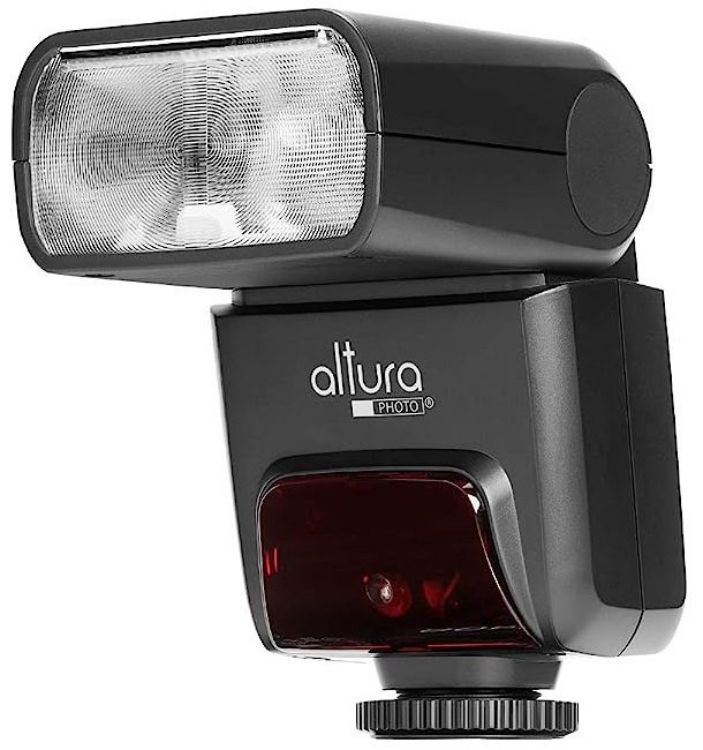
Overview– It’s not like, we have to just click the picture, but it’s about cherishing them in memories which is why I strongly recommend you not to fall for any ordinary tool and always go pro.
This time with my trusted companion Altura Photo AP-305C here, which adds a touch of lighting magic to my R6 and R6 II during each shot gracefully.
Okay, truth be said, from the moment I attached the flash to my camera, I was drawn to its simplicity and functionality. The wondrous compatibility with my Canon R6 and R6 II comes as a piece of cake, while the ability to add creativity makes it an essential addition to my photography kit. The flash comes with a decent power range.
With the guide number of 36m at ISO 100, the flash holds the power to illuminate the subject and surroundings with one stroke of lighting.
Now what makes it better is all Mighty TTL because it won’t let you struggle with the camera setting but easily coordinates with the camera and fills the frame with the proper exposure level.
With its way of intelligently calculating exposure, TTL Mode saves me precious time during fast-paced shoots. In contrast, the other Manual, Multi, and other modes add versatility factor to flash.
No matter if I am shooting an event, wedding, or vibrant landscape, the high-speed sync feature enables me to overcome harsh lighting conditions and create stunning portraits even in bright sunlight matching through the camera’s settings.
The AP-305C’s user-friendly design genuinely separates it from any other ordinary lighting tool in the market. Navigating through its numerous modes and options is a pleasure, thanks to properly labeled buttons and an easy layout.
The adjustable flash head, on the other hand, makes it possible for me to experiment with different lighting angles and orientations. Together with the display panel, it all gives a professional touch to filming as well as footage.
Nothing would beat its compact yet professional body; with the 30% lighter approach, the brand Altura Photo takes a big step in thinking about customer convenience as well as numerous angles and distance shooting.
Although The AP-305C speedlight flash doesn’t compromise on performance either, you might gather it from now on.
What made me buy it?
- Pocket-Sized Power
- Speedy and Easy Setup
- Travel-Friendly
- TTL versatility
- Cost Effective tag
- Included mini stand
What can be improved?
- Limited Features
- Build Quality
4. Godox V850III Manual Speedlight Flash for Canon R6 & R6 II
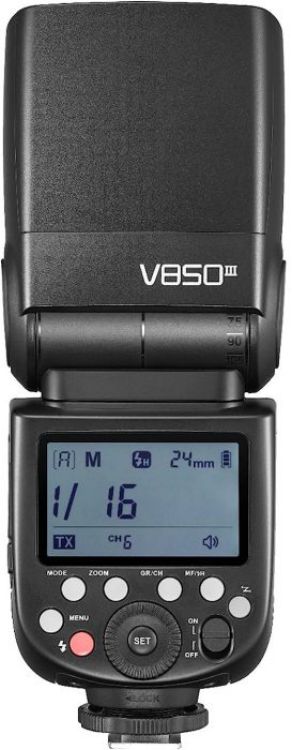
Overview– If you too believe lighting is the key to unlocking creativity, This Godox V850III TTL Flash here is to prove you are light. With its exceptional brilliance, it makes the finest and a wonderful illumination companion to any cinematic journey with all the advanced features.
V850III empowers every photographer to shape the light according to their artistic intent; What possibly could anyone want more?
Designed to seamlessly pair with Canon R6 & R6 II cameras, the V850III boasts a robust build and exceptional performance. So I am going to begin with its power.
With the advanced guide number of 60 at ISO 100, the flash continues delivering its exceptional lighting throughout the footage, no doubt intended. But it’s not about power. It’s about how the illumination came.
This brings me to the V850III flash’s precise control over the lighting environment. The zooming flash head adapts to different focal lengths intricately, from 20mm to 200mm, ensuring even coverage across various subjects.
It helped me capture wide-angle or narrower shots according to my creative vision. The flash lacks TTL mode, which might be a little turn-off but guarantees other ways to seek professionalism.
For instance, HSS, High-Speed Sync, here is a game-changer, which allows me to go above and beyond photography, freezing fast-paced action shots or shooting wide open in bright conditions, or even enhancing the range of shots.
This feature comes in exclusively handy. While the other Multi, Manual, and slave masters do create magic when needed.
The V850III’s wireless capabilities are where it truly shines. With its built-in 2.4GHz wireless X system, I can control multiple flashes remotely; but it also includes a transmitter and receiver function, which makes narrating through different modes effortlessly easy.
And the intuitive LCD panel, along with other device dials and buttons, is convenient for keeping pace with real-time updates.
As an additional factor to flexibility, the flash can move around to manage the light intensity or create a shadow effect; this can be achievable by Flash’s tilting ability. And speed was never an issue thanks to the fastest recycle time.
Last but not least, the battery, of course, the rechargeable lithium-ion battery, is wonderfully active with the maximum number of flashes possible on a single charge.
What made me buy it?
- Quick Control
- Versatile flash lighting
- LCD Display
- High-Speed Sync
- Creative Possibilities
- Wireless Mastery
What can be improved?
- Bulky Build
- Lack TTL
5. Altura Photo AP-UNV2 Camera Flash for Canon R6 & R6 II
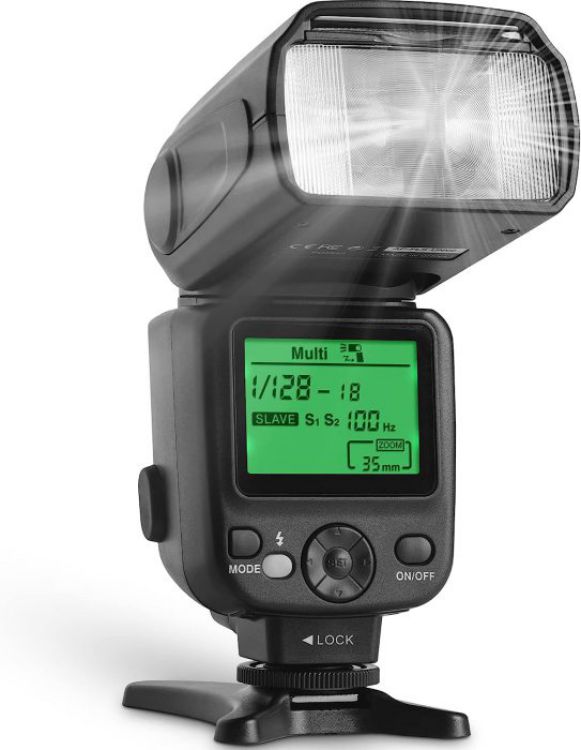
Overview– To master the art of capturing fleeting moments and turning them into everlasting memories, I held the hand of the most reasonable and affordable flash for Canon R6 and R6 II, the very own Altura Photo AP-UNV2.
It has become an indispensable tool in my pursuit of freezing precious moments with utmost clarity, brightness, and details and eventually transforming it into captivating images.
The most convenient and user-friendly flash, Designed to go hand-to-hand smoothly with both Canon R6 or R6 II cameras. The fun fact is this seamless connection between them allows me to focus on my creative process without distraction from technology needs and what to do. And with its reasonable price tag, AP-UNV2 is an affordable flash for Canon R6 and R6 II.
First thing first, the flash’s compact design and user-friendly interface is what makes it stand out. I couldn’t believe its weight the first time I saw it, but despite its small size, it does manage to pack a punch in terms of performance.
The guide number, for instance, 38m at ISO 100, is decent enough to brighten up my image with the proper distribution.
However, the flash doesn’t include TTL expertise, but it does encourage the creativity and authenticity of TTL by offering other active modes such as multi-flash for artistic effect in frame or manual for better exposure locks and stuff and the optical slave master for using it with any camera with flash.
I admire the flash’s quick recycling time, which revolves around 2.9 seconds. It ensures that I’m always ready to capture the next moment, be it a candid smile or a dynamic action shot.
In addition, the flash also has a wide-angle diffuser so that you or I can experiment with the diffusion of light and embrace soft and dynamic lighting through the reflector card included.
It’s also about convenience. The effortless wireless triggering system enables off-camera flash techniques, giving me the freedom to explore different lighting setups.
While the Four AA batteries make sure the flash firing cycle lasts for an extended time without running out of power frequently, which is more than enough for a regular or beginner photographer.
What made me buy it?
- Compact Powerhouse
- Easy Learning
- Exceptionally cheap
- Portable Partner
- Backlit Display
- Diffuser included
What can be improved?
- Limited Flash Modes
- Modest Features
Common mistakes to avoid while using an external flash

External flashes are powerful tools for enhancing your photography by providing controlled lighting in various situations. These tools hold the raw power to transform your shot into a majestical-looking masterpiece with the slightest burst of illumination strategically.
However, as admirable as these flashes sound, there are certain flaws that can be admitted in your operation if you are not careful enough; even professionals can fall victim to certain mistakes.
On the bright side, I have decided to uncover several such pitfalls that you may adapt while flashing photography; staying away from these mistakes can help you achieve stunning results in your filming game.
Directing the flash- Do not make the mistake of aiming the external flash directly at your subject; This is the reason that harsh shadow and unflattering highlights damage the footage.
What to do– Instead, bounce the flash off ceilings, walls, or diffusers to achieve softer and even lighting.
Too much Natural light– If you are using too much of your flash or intensified flash power in a well-lit outdoor environment, there are chances you end up catching an unnaturally illuminated subject
What to do– Adjust the flash intensity to balance with the available natural light, maintaining a blend-in soft look.
Neglecting Manual Mode– Some people are so fascinated by TTL mode they bury the Manual mode under 6 feet; don’t do that. Disregarding the manual mode can lead to unpredictable exposure in your footage.
What to do– Choose the appropriate mode based on the situation for consistent results.
Not considering the flash distance– Positioning the flash too close to the subject can create an area with overexposure or washed-out details due to lighting.
What to do– Maintain a reasonable distance between the flash and the subject.
Avoiding the flash angle– So, ignoring the angle of the external flash and the direction of its burst can lead to flat and lifeless images. They fail to create images with sharpness or clarity.
What to do– Experiment with different angles to add depth, texture, and dimension to your subjects.
Failing to sync properly– Incorrect flash synchronization can result in images with black bars or partially illuminated scenes. This is a very rare known fact which is why people often make the mistake of syncing the flash correctly.
What to do– Make sure you verify the camera’s sync setting and capability to prevent this issue.
Sticking to the same flash mode– Different surrounding or different photography style demands different flash modes. Neglecting to switch between modes can lead to constant ordinality and boredom in your shot as well as a mismatch of illumination levels as well.
What to do– Always experiment with different shooting modes and templates.
Running out of battery– Interruption caused in the mid-shoot due to battery drainage is the photographer’s biggest nightmare. For instance, you are shooting a significant scene in an event, and your battery runs out.
What to do– So always carry a spare battery in your pocket to avoid such trouble.
By sidestepping these common mistakes, one makes in flash photography; you’ll harness the full potential of your external flash, transforming your ground-level ordinary scenes into extraordinary photographic masterpieces. Just remember, practice is the key.
Frequently Asked Questions (FAQs)
Q. What’s the purpose of a diffuser for flashes?
A diffuser for flashes serves to soften and scatter the harsh, direct light produced by a flash unit. It is frequently used in photography to provide more attractive and natural-looking lighting. A diffuser generates softer and more uniform lighting on the topic by spreading the light across a greater area and minimizing sharp shadows. This is particularly useful for portraits, close-ups, and scenes where softer, diffused lighting improves the overall aesthetics.
Q. How to extend my flash’s battery life?
There are a few tactics that optimize battery usage, making sure that dependable performance can be experienced during long photography endeavors. This strategy keeps your battery functional for years after years. What you need to do is
- Activate Power Saving Mode
- Use Original and quality recharging tool
- Manage the Power Level
- Turn off the idle mode
- Keep your flash off during breaks
- Explore more external power source
- Remove batteries while storing the flash
Q. What’s rear curtain sync in flash photography?
Rear curtain sync, sometimes also known as “second curtain sync,” is a flash photography technique that regulates when the flash fires with the coordination to the shutter movement of the camera. In rear curtain sync, the flash fires shortly before the camera’s rear curtain (the second curtain) begins to close, just before the exposure ends. This produces an eye-catching light trail in photographs with moving subjects and long exposures.
Final Words
So now our exploration of the finest flashes for Canon R6 and R6 II comes close to the end; I am left with a vibrant spirit to get on shooting perfection.
However, you should know the perfect flash isn’t just a device- it’s a medium through which creativity flows, shaping the interplay between light and shadow.
As the article traversed through the series of articles, I crossed my fingers in the hope that you have found an ideal flash for your camera.
Nevertheless, remember the best flash isn’t a one-fits-all solution; it needs to be chosen wisely to amplify your skills and push your boundaries.
Armed with this comprehensive guide, you can do that effortlessly. So, which will it be? Don’t forget to let me know in the comment below.
Until then, fly with your unwavering passion and capture life’s precious moments with details, clarity, and perfection.




